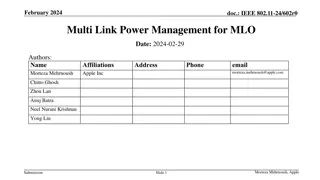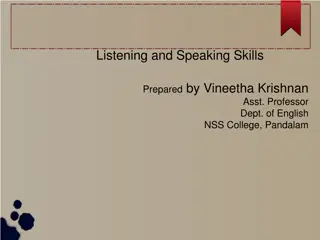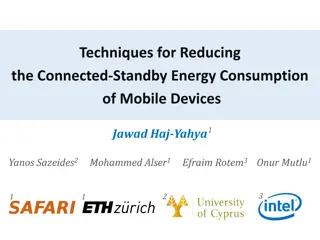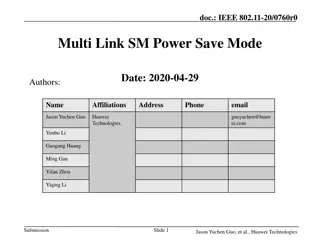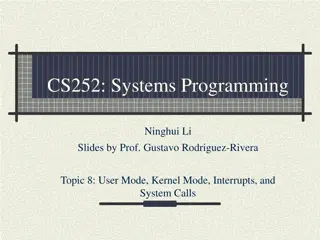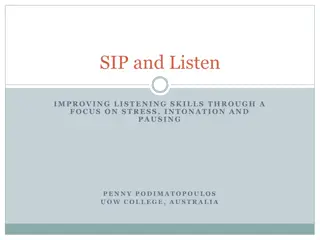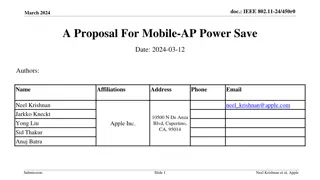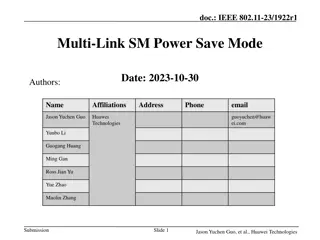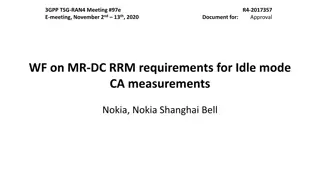Follow-Up on Low-Power Listening Mode - Summary of Power Consumption Data
This document provides a follow-up on the low-power listening mode with additional data to address previous questions. It includes power consumption details of the connectivity module in smartphones, highlighting the significant impact of Wi-Fi module power drain. The power consumption order and energy consumption over time clarifications are also discussed, along with considerations on implementation-based low-power listening. The data offers insights into power management strategies for wireless communication technologies.
Download Presentation

Please find below an Image/Link to download the presentation.
The content on the website is provided AS IS for your information and personal use only. It may not be sold, licensed, or shared on other websites without obtaining consent from the author.If you encounter any issues during the download, it is possible that the publisher has removed the file from their server.
You are allowed to download the files provided on this website for personal or commercial use, subject to the condition that they are used lawfully. All files are the property of their respective owners.
The content on the website is provided AS IS for your information and personal use only. It may not be sold, licensed, or shared on other websites without obtaining consent from the author.
E N D
Presentation Transcript
Nov. 2022 doc.: IEEE 802.11-22/1841r0 Follow up on the low power listening mode Date: 10/31/22 Authors Affiliations Address Email Xiaogang Chen ZEKU 2479 E Bayshore Road, Suite 260. Palo Alto, CA Xiaogang.chen@zeku.com Ivan Yu Bo Wang Yanchao Xu Yi-Hsiu Wang Submission Slide 1 Xiaogang Chen et al. (ZEKU)
Nov. 2022 doc.: IEEE 802.11-22/1841r0 Outline More data to answer/clarify questions from the last F2F regarding the proposal of low power listening in [1]. The differentiations with implementation-based solution. Summary Submission Slide 2 Xiaogang Chen et al. (ZEKU)
Nov. 2022 doc.: IEEE 802.11-22/1841r0 Power consumptions of the connectivity module in smart phone Indoor Positioning 10.37% Streaming Shopping News Gaming Modules\APPs 5.53% 3.23% 3.98% 6.86% Connectivity (Wi-Fi) 35.31% 23.91% 29.14% 30.02% 38.98% CPU 1.97% 1.18% 1.49% 1.26% 5.33% GPU 23.03% 51.20% 41.92% 34.98% 16.33% LCD 12.28% 6.08% 7.23% 6.54% 12.24% Memory 4.73% 0.05% 1.37% 0.95% 2.19% Audio Miscs 17.14% 14.35% 14.86% 15.89% 18.06% Observations: The power consumption of Wi-Fi module varies from ~3% to ~10% depends on the apps; Compare with other modules, Wi-Fi module can be considered as a major source of power drain. The measurement is conducted for smartphone. Power draw for connectivity maybe larger for IoT device. Power consumptions are always benchmarked for each individual module including connectivity. Submission Slide 3 Xiaogang Chen etc. (ZEKU)
Nov. 2022 doc.: IEEE 802.11-22/1841r0 Clarifications on the power consumption Figure on the bottom right is the energy consumption accumulating over time. Order of the power consumption: sleeping < listening < Rx < Tx; Order of the time duration: Tx < Rx < listening < sleeping; Energy consumption (accumulating over time) of Listening is higher than sleeping/Tx/Rx. Submission Xiaogang Chen et al. (ZEKU)
Nov. 2022 doc.: IEEE 802.11-22/1841r0 Considerations on implementation-based LPL (1/2) HP Path Ramp up Transition from Transition from Upon packet detected LP to HP HP to LP LowPwr HighPwr LowPwr RTS/Trigger Pre-EHT field EHT modulated field AP CTS BA STA mW Time Incoming Packed HP path ramp up due to False Triggered No AID Match confirmed HP ramp up always needs XXus to settle depends on implementation; HP ramp up based on packet detection will introduce false trigger; Intro-PPDU LP to HP switch is not free Need a slot to switch while the Pre-EHT portion needs to be received; Difficult to reuse the Phase tracking during the Pre-EHT portion. Submission Xiaogang Chen et al. (ZEKU)
Nov. 2022 doc.: IEEE 802.11-22/1841r0 Considerations on implementation-based LPL (2/2) Initial Frame RTS/Trigger Pre-EHT field EHT modulated field AP CTS BA STA STA Not addressed in RTS mW STA addressed in RTS Alt.1 STA addressed in RTS Alt.2 Time The initial frame provides flexibility for implementation on the listening operation. Different implementations can choose their preferred alternative to leverage the initial frame and trade off. Submission Slide 6 Xiaogang Chen etc. (ZEKU)
Nov. 2022 doc.: IEEE 802.11-22/1841r0 Summary Given the analysis in the slides, [1] and the agreements upon the formation of the UHR SG (recapped below), it is highly recommended to include Reducing device level power consumption in the PAR. The Study Group will investigate technology which may improve reliability of WLAN connectivity, reduce latencies, increase manageability, increase throughputincluding at different SNR levels, and reduce device level power consumption Submission Xiaogang Chen et al. (ZEKU)
Nov. 2022 doc.: IEEE 802.11-22/1841r0 Reference [1] 11-22-1414-01-0uhr-LPL. Submission Slide 8 Xiaogang Chen etc. (ZEKU)
Nov. 2022 doc.: IEEE 802.11-22/1841r0 Backup:Power consumptions break down (copied from [1]) If LPL (Low Power Listening) module is introduced in RF, the power consumption will be scaled down as in the table below: Significant amount of power consumption can be saved in RF with a dedicated LPL mode. 160MHz HP 20MHz HP 20MHz LP 2 Chain 2 Chain 1 Chain PLL 100% 100% 7% ADC 100% 19% 3% Others 100% 66% 14% Total 100% 63% 9% Note: Normalized per row based on 160MHz HP Submission Slide 9 Xiaogang Chen et al. (ZEKU)




